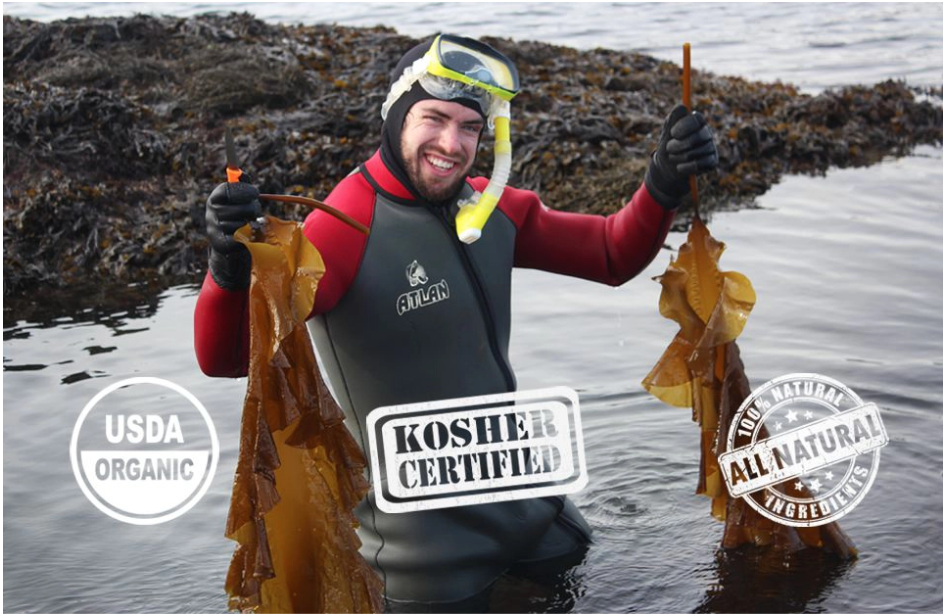When I sat down at a Portland kombucha bar to attend a local Seaweed 101 session, I fully expected a love story about wild, vegan kelp and how we can change the world by eating more sea vegetables. What I didn't expect was an in-depth exchange about federal fishery management and how it has decimated the industry's communities in New England.
VitaminSea owner, and host of the session, Tom Roth was a commercial tilefish captain out of New Jersey a lifetime ago. He transitioned into New York Harbor tugboats as the industry declined, and started diving for kelp in his spare time from his home base in southern Maine about 15 years ago.
These days he goes out in a 40-foot boat that carries three other divers, two wooden skiffs and two Zodiacs. Each diver takes a small craft out on his own; they spread out, harvest, then meet back at the boat to help each other unload.
Tom's wife, Kelly, is the mostly shore-based marketing mind behind VitaminSea's astounding range of products, which includes dried and smoked seaweed products from nine native, wild varieties in Maine, as well as a remarkable catalog of recipes for all of their products.
The company collects product from about 40 harvesters all along the coast of Maine. VitaminSea helps these partners get set up for drying in their own greenhouses. The Roths themselves have 220 12-foot-long tables in their fields at home, which they use to turn loads of 10,000 pounds of wet kelp into 1,000 pounds of dried, marketable product. Last year, the company harvested about 140,000 pounds of dulse, noting that each harvester can collect an average of 1,000 pounds (wet) per day.
But this is not your average dulse. Straight out of the bag, it's soft and velvety, almost like dried fruit. Tom says the secret is in what he calls "slackening."
"Let it dry, then let the night air soften it before packaging," he says. Those packages have a shelf life of about two years. But they rarely stick around that long.
"I get calls all the time" for more orders, Tom says. "But I can't grow [the business] unless I start farming."
About 90 percent of VitaminSea's product is wild, with the small remainder coming from two small, seasonal lease areas, where they're growing some kelp.
All of the company's product comes from MOFGA-certified seaweed beds, which makes VitaminSea the first seaweed company to be certified by the Maine Organic Farmers and Gardeners Association. They also carry the less-stringent USDA organic label, along with vegan and kosher certifications.
It's clear throughout the presentation that this veteran seaweed harvester takes his stewardship of the resource seriously. He rattles off the fundamentals of sustainable seaweed harvesting off the coast of Maine:
• 50 percent of the bed must be left behind
• The cutting height is 16 inches above the lateral branches (this is akin to pruning and allows the plant to leaf out again)
• Cut out any oyster leaf you see.
"It creates problems on the beds. It will take over," Tom says of the invasive oyster leaf. Although it's a native plant, sea lettuce isn't farmed in Maine waters "because it can bloom out of control. It grows on every lobster buoy," Tom says. "But you can't grow it on purpose."
He also recognizes that a decline of natural predators has helped the industry grow. Seaweed harvesters have a unique perspective and role in understanding inshore biodynamics.
"Urchin depletion has led to flourishing kelp beds. But urchins are coming back. Periwinkles also eat kelp," he says, noting that they can become a nuisance for wild harvesters.
This dialed-in and deep understanding of the both the regulations and shoal-water conditions reminds me why fishermen are naturals for growing and harvesting seaweed — that and a tendency to stray from the 9 to 5.
"We're like gypsies," Tom says. "We go all over."
Tom Roth hasn't lost that combination of wanderlust, stewardship and passion for the ocean's bounty that made him a great fisherman. He just invested his efforts into the next high tide.
The world's first Seaweed Week kicks off in Maine on Friday, April 26, in celebration of the spring kelp harvest. Stay tuned here for highlights from Seaweed Week.
Why Seaweed Matters is the first of a series of events on the Blue Economy hosted by the New England Ocean Cluster with collaboration from Startup Maine and sponsored by the Maine Center for Graduate and Professional Studies.








